Table of contents
- PS-Technik series part 5 Lubrication systems
- The smallest disturbances can collapse the lubrication system
- Oil not only lubricates, oil also cools where things get really hot
- Quieter and less vibration of the engine
- Forced lubrication and oil pump
- Air / oil cooling and bearing damage
- Dry sump lubrication
- Wet sump lubrication
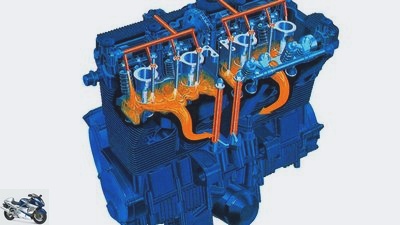
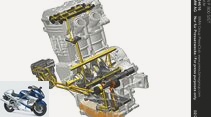
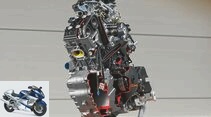
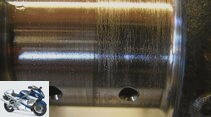
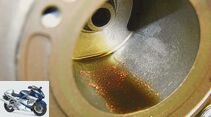
17th pictures

archive
1/17
The BMW F 800 engine, with its oil ducts running through it, shows how complex the pressure circulating lubrication is.
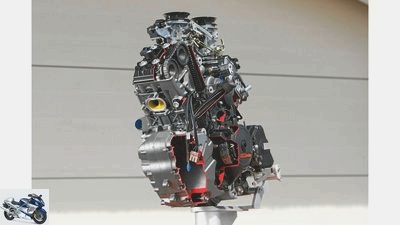
archive
2/17
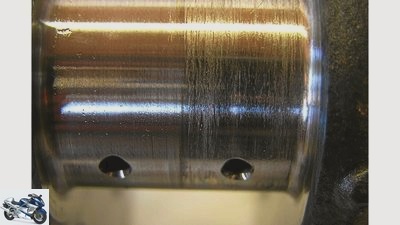
archive
3/17
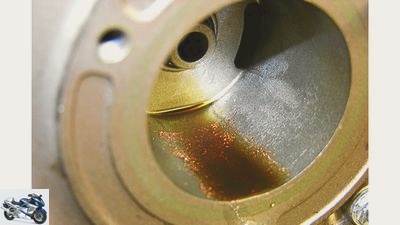
archive
4/17

archive
5/17
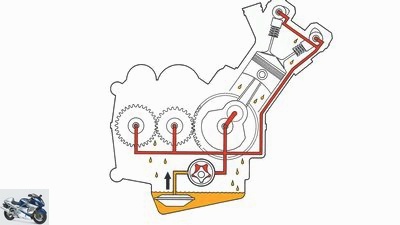
archive
6/17
Simple, light, reliable: wet sump lubrication.
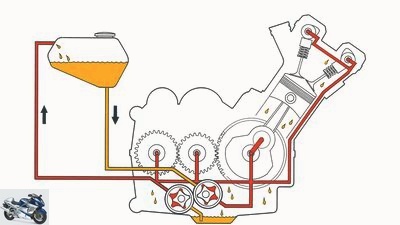
archive
7/17
Dry sump lubrication: circuit from the oil tank to the pressure pump (yellow), circuit from the pressure pump to the engine lubrication point (red).
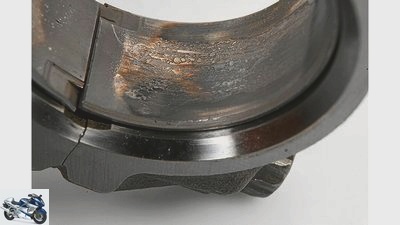
archive
8/17
Except for the brass layer, the bearing on the connecting rod foot has been worn away.
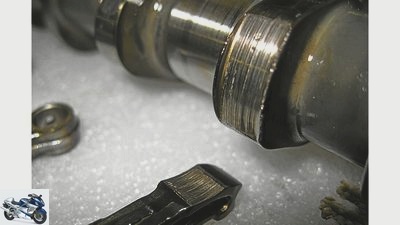
archive
9/17
Insufficiently hard surface on the BMW S 1000 RR camshafts.
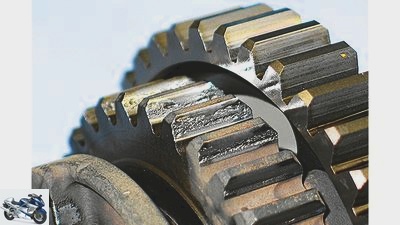
archive
10/17
Breakouts on the gear can also be found in the oil filter.
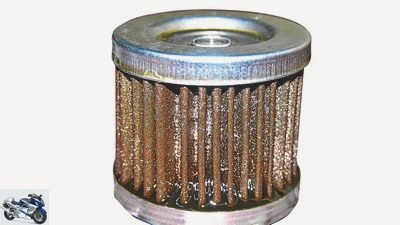
archive
11/17
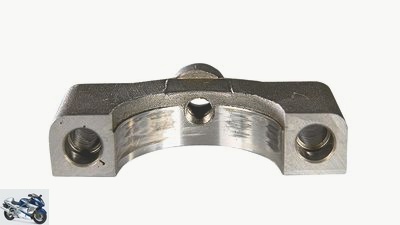
archive
12/17
Camshafts mounted directly in the aluminum can quickly be destroyed by a lack of oil.
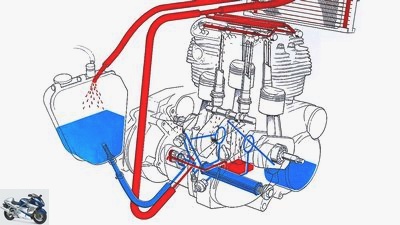
archive
13/17
Classic Triumph Trident engine with dry sump lubrication and oil cooling on the cylinder head.
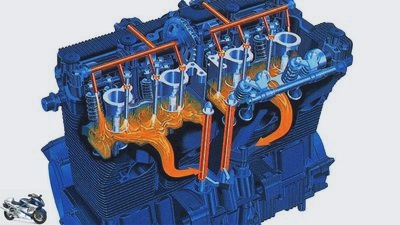
archive
14/17
Suzuki GSX-R four-cylinder with SACS oil cooling, which washes especially around the hot outlet zones.

archive
15/17
Eccentrically mounted gear rotors press the oil into the lubrication points.
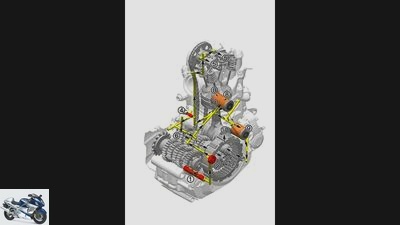
archive
16/17
With this lubrication system, one or more pumps press the engine oil, regardless of whether it is a dry or wet sump, through channels to the bearings and lubrication points.
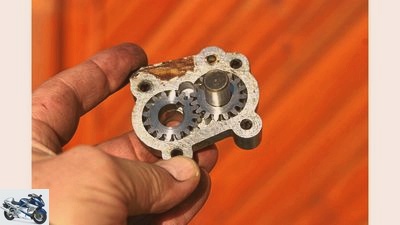
archive
17/17
counselor
technology & future
Lubrication systems
PS-Technik series part 5
Lubrication systems
Content of
Only a reliable lubrication system is able to supply all components with oil up to the highest speeds. But the honey-yellow lubricant’s tasks are far from over.
Werner Koch
08/20/2013
When two surfaces rub against each other, heat is generated. This is also an indicator that kinetic energy is being converted into useless waste heat. After all, the motor should provide movement and not heating the air. In order to minimize the contact between the two surfaces, in our case the shafts, pistons and bearings, the oil in the plain bearings is pressed between the surfaces with a certain pressure via a bore system. For this, however, it is necessary that the oil film can spread in a free space, the bearing clearance. If the play is too small, the friction and also the risk of bearing damage increases. If the play is too great, the oil pressure evaporates from the side of the bearing, which in this case can also increase friction and even damage the bearing.
Buy complete article

PS-Technik series part 5
Lubrication systems
5 pages) as PDF
€ 2.00
Buy now
If the bearing clearance of the plain bearings is correct (depending on the diameter 0.010 mm to a maximum of 0.10 mm for the connecting rod bearing), an oil pressure of around 2 to 4 bar ensures a long service life, minimal friction and thus low power losses, i.e. higher engine power. If the oil pressure drops below around 1.5 bar, the lubricating film breaks down, the bearings run dry and seize.
However, too high an oil pressure damages the so-called three-substance bearings. The hard oil jet literally flushes the relatively soft bearing metals on the surface out of their seat and irreparably destroys them. This happens if, for example, the pressure relief valve does not open and the maximum possible oil pressure of the pumps acts on the bearings.

workshop
PS technology special
Further training for motorcyclists
read more
The smallest disturbances can collapse the lubrication system

archive
The BMW F 800 engine, with its oil ducts running through it, shows how complex the pressure circulating lubrication is.
Probably the most common cause of damage to crankshafts and connecting rod bearings is too low an oil level in the engine or oil tank. Particularly at higher speeds, the oil requirement increases sharply due to the oil pressure pump, because the oil, which is distributed throughout the engine and gearbox, only runs back into the oil pan with a delay. There the level drops so far that the trunk of the oil pump sucks in air instead of oil and as a result the pressure in the lubrication system collapses.
The red oil pressure light in the cockpit then lights up as a visual warning signal. Not to be confused with the oil level control, which only shows that the level is too low. The moment the oil pressure drops, the friction of the slide bearings increases enormously, the surface made of the tin alloy heats up and begins to smear, and engine damage cannot be stopped. Even if the oil pressure stabilizes again, the bearing is so far damaged that the final collapse is only a matter of time.
If one increasingly hears knocking engine noises, one can often make out the particles of the attacked bearing when draining and inspecting the engine oil and thoroughly rubbing out the oil filter chamber or the oil pan. Which precludes further, no matter how gentle, driving under all circumstances. Also because bearing damage in the early stages can usually still be repaired and no other components have been affected. However, if the connecting rod or crankshaft has worked its way up to a complete mechanical failure, new parts are needed. And that blows quite a hole in the till. Of course, the quality and viscosity of the oil also play a fundamental role in lubrication. In principle, engine oils should always comply with the regulations of the engine manufacturer.
Oil not only lubricates, oil also cools where things get really hot
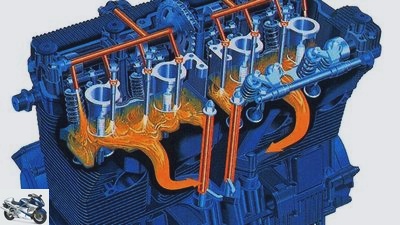
archive
Suzuki GSX-R four-cylinder with SACS oil cooling, which washes especially around the hot outlet zones.
The hottest areas of the engine are where the combustion takes place: in the cylinder head and on the piston crown. Even if the cooling water surrounds the extremely hot area in the exhaust duct, the engine oil absorbs a large part of the heat and transports it to the fresh air via the heat exchanger or a special lamellar oil cooler. This is the only way for the designers to prevent heat collapse.
The Suzuki GSX-R engines demonstrated how heat dissipation through the lubricating oil works until the early 1990s. Under the name SACS (Suzuki Advanced Cooling System), the sports and racing engines were kept thermally in the green area by means of an ingenious oil flow through the engine and a large oil cooler. The piston racing up and down is nowadays cooled in almost all engines by a nozzle in the crankcase and the targeted oil jet from below onto the piston crown. The fact that the upper piston pin bearing is also hit by the spray oil is intentional, because this is the only plain bearing in the crank drive that is not supplied with oil pressure. The reason: the connecting rod would be weakened by an oil hole along the connecting rod. In addition, the extreme accelerations of the connecting rod would not guarantee a constant supply.
Hellish temperatures of up to 400 degrees and a constantly changing air gap overwhelm any seal. For example on the piston rings, which only guarantee a perfect seal if the oil closes the smallest pores and free spaces and prevents the combustion pressure from flowing through.
Quieter and less vibration of the engine
All Simmerrings and labyrinth seals are also supported in their function by the oil. In addition, the oil ensures a reduction in the friction between the shaft and the sealing lip, which would be destroyed in no time, especially at high speeds without oil.
The oil cushion, which is deposited between all moving parts, also cushions and cushions the hard metallic movements of many components and in this way ensures that the engine runs more quietly and with less vibration.
Because every motor is subject to permanent mechanical wear, even the finest abrasion and chips occur. High-quality engine oils collect these, keep them in suspension and transport them to the filter. There the particles settle in a close-knit network of fine-pored paper before they reach the sensitive slide bearing points via the oil pump and would permanently destroy them.
Gaseous and aggressive substances that get into the crankcase via the piston rings during so-called “blow-by” and cannot be filtered are absorbed by the oil, neutralized and disposed of when the oil is changed. In addition to cleaning, oil also has the task of permanently protecting all components, regardless of whether they are made of aluminum or steel, from corrosion.
Forced lubrication and oil pump

archive
Eccentrically mounted gear rotors press the oil into the lubrication points.
With the lubrication system, one or more pumps press the engine oil, regardless of whether it is a dry or wet sump, through channels to the bearings and lubrication points. In addition to the moving engine parts, the oil is also directed to or into the transmission shafts and to the oil bath clutch. Because in modern engines this runs far above the oil sump in order to avoid slipping losses. When starting up with a slipping clutch, it must be lubricated and cooled by a certain amount of oil. If this does not happen, or if this does not happen, the friction disks, which are often coated with organic materials, will burn. One or, as shown in the sketch above, two oil filters ensure that the abrasion from the clutch, slide bearings and small cracks on the gear wheels (pitting) do not get into the pressure circuit and thus into the sensitive bearings.
In many motorcycle engines, the oil pressure is built up by a gear pump, more precisely: a trochoid pump. This sucks the oil over a long snorkel at almost the lowest point of the oil pan. The oil is only cleaned by a relatively coarse-meshed metal sieve, which can lead to metallic residues being rolled through the hardened gear pairs and leaving grooves there. The oil pump is driven via an intermediate shaft from the crankshaft via gear wheels or a maintenance-free roller chain.
The most popular engines with the coupling of lubrication and cooling came from the first GSX-R 750 R from 1985 to the last “real” Bandit 1200 from 2006 by Suzuki, which equipped their finely ribbed four-cylinder with SACS oil cooling. A second oil pump presses the lubricant in large quantities through the hot zones in the cylinder head. From there it goes to the large oil cooler below the steering head. The classic Triumph Trident engines from the 1970s also supported air cooling with an oil circuit in which an oil cooler was interposed before the oil was pumped back into the side oil tank of the dry sump lubrication.
Air / oil cooling and bearing damage
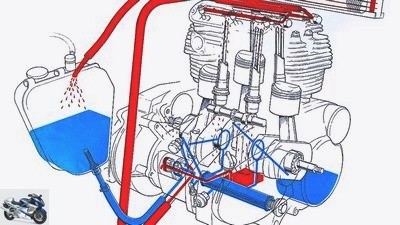
archive
Classic Triumph Trident engine with dry sump lubrication and oil cooling on the cylinder head.
Due to the poor thermal conductivity of oil (thermal conductivity number: oil 0.15, water 0.55), this construction principle does not even come close to achieving the effect of water cooling, but it can support this efficiently, as the oil is in direct contact with the moving and highly heated engine components. In principle, every combustion engine works with an additional oil cooling system, which is released either via the engine surface or a special heat exchanger.
Bearing damage is usually indicated by clearly visible particles in the oil or in the oil filter. Experienced mechanics can use a visual inspection of the deposited material to see which bearings or components are damaged. In the case of brass, the cages of roller bearings dissolve, gray, fine tin deposits come from the three-material plain bearings, aluminum chips mostly come from the camshaft bearings and small, pointed metal flakes can be assigned to the gear wheels (pitting or claw wear). If you want to know exactly, you can use an oil analysis in the laboratory to determine the wear of all lubricated components that are at risk of wear. If the abrasion particles are already stored in large quantities in the filter (see photo), only complete engine disassembly will help to prevent a total loss.
Dry sump lubrication
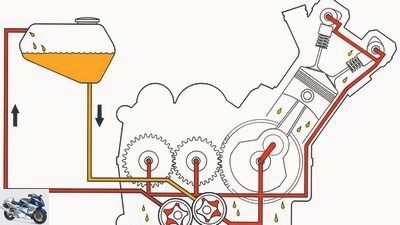
archive
Yellow: circuit from the oil tank to the pressure pump, red: circuit from the pressure pump to the engine lubrication point.
The dry sump lubrication works absolutely reliably even in extreme situations. With this lubrication system
the oil is sucked from the lowest point in the engine by one or more return pumps and pumped into a separate oil reservoir. This reservoir can be housed in a sheet metal tank or in a space cast directly onto the engine block (KTM RC8). Regardless of whether the oil tank is high or low, the oil is sucked out of the tank by a second, the so-called pressure pump, and fed into the oil pressure circuit.
Thanks to the freedom of design and positioning of the oil tank, it can be optimally integrated into the overall package of center of gravity and mass concentration. The greatest advantage of dry sump lubrication, however, is that the supply of the pressure pump is guaranteed even when the motorcycle is exposed to extreme driving situations. No matter how high the longitudinal or lateral accelerations are, the oil always remains so compact that the pressure pump cannot draw any air. The disadvantages: The return pump eats up performance, and components such as the tank and oil lines increase costs and weight.
Wet sump lubrication
Simple, light, reliable: wet sump lubrication. In the most frequently installed lubrication system, an oil pump pushes the lubricant through the oil ducts to the bearing points, from where the oil flows back through generously dimensioned return bores into the deep-lying oil pan. The advantages of this system: You only need one oil pump and the complete oil circuit takes place inside the motor housing. If the oil pan is large enough, the oil can cool down sufficiently. Only in extreme driving situations, such as sharp braking maneuvers from high speeds, does the oil move from the oil pan forward into the engine compartment due to the inertia force. In this case, the oil pump can suck in air instead of oil, which leads to a loss of oil pressure at the bearing points and, in the worst case, to engine damage.
Related articles
-
Drawing: archive counselor technology & future Technology guide: lubrication Technology guide: lubrication Knowledge: Nothing works without oil From the…
-
Guide: Technology – engine lubrication
BILLION counselor workshop Guide: Technology – engine lubrication Guide: Technology – Motors and Drive Everything about engine lubrication To ensure…
-
Tips for mechanics: Maintenance of motorcycle cooling systems
Ralf Petersen 15th pictures Ralf Petersen 1/15 We explain how the maintenance of a cooling system works. Ralf Petersen 2/15 This is needed for…
-
Ducati 1299 Panigale assistance systems coordinate setup
markus-jahn.com 28 pictures fact 1/28 Ducati Superbikes in a generation comparison. fact 2/28 Bite-proof and easy to dose: anchor of the 1198. ABS was…
-
Defects in anti-lock braking systems
BMW motorcycles Defects in anti-lock braking systems Defects in anti-lock braking systems Failure symptoms ABS is the most important, oldest and most…
-
4 lean ABS systems in the endurance test
4 lean ABS systems in the endurance test Lean ABS systems put to the test 4 current curve anti-lock braking systems in comparison Full in the irons with…
-
Exhaust systems for BMW R 1100 S.
accesories Exhaust & silencer Exhaust systems for BMW R 1100 S. Exhaust systems for BMW R 1100 S. Heck-Meck Do accessory exhaust systems make the BMW R…
-
Scottoiler xSystem electronic chain lubrication system
Scottoiler 5 pictures Scottoiler 1/5 Scottoiler 2/5 Scottoiler 3/5 Scottoiler 4/5 Scottoiler 5/5 The new xSystem has the dimensions 150x46x45 mm and…
-
Conversion tips exhaust systems
Hanselmann 8th pictures Debus 1/8 In principle, there are two options when the exhaust is to be replaced. Here is a completely new system from Akrapovic,…
-
Motorcycle exhaust systems from SR-Racing
fact 18th pictures fact 1/18 Sepp Bruckschlogl is the master of the pipes and head of SR-Racing. fact 2/18 Components of the silencer. fact 3/18 Shapes…